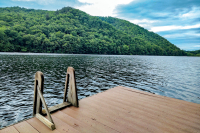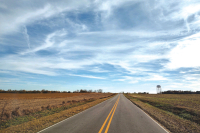Sandwich boards: if you can’t beat ‘em, join ‘em
Judge not lest ye be judged.
The Waynesville Planning Board is delving into the town’s sign ordinance to create more uniform, yet more permissive signs in its three downtown shopping districts — greater Main Street, Frog Level and Hazelwood — something that can appease at least most business owners.
The sticky wicket of downtown sandwich boards
 Signs are businesses’ equivalent to nuclear weapons.
Signs are businesses’ equivalent to nuclear weapons.
“Everybody wants them, but you have to agree to live with them,” said Waynesville Town Planner Paul Benson. “I think what we need is a consensus on what is a reasonable approach.”
Neighbors hit snag in quest to rename road
 Hate the name of your street? In Haywood County, changing it shouldn’t be that hard.
Hate the name of your street? In Haywood County, changing it shouldn’t be that hard.
Come up with a new name, make sure the name isn’t already taken by another street and get at least 65 percent of your neighbors to agree.
Scoring coveted brown highway signs can pay off
Nantahala-bound travelers will notice a suite of new, officially-sanctioned, brown roadside directional signs declaring they are on the right track to the renowned paddling Mecca — signs that rafting outfitters in the Nantahala Gorge hope will alleviate the problems caused by ineffectual GPS.
For those who know, driving to the Nantahala Gorge is simple. Just follow U.S. 74 past Bryson City and you’re there. But, for those who don’t, a.k.a. the tourists who visit Nantahala to raft, kayak or hike, the journey can be tricky.
Tourists caught in the middle not amused by tit-for-tat Cherokee sign debate
Pity the poor visitors trying to find their ways to Cherokee if the N.C. Department of Transportation heeds requests of local leaders in Haywood and Jackson counties when it comes to directional signs.
First, Jackson County wanted a “This way Cherokee” sign added in Haywood County that would bring visitors past their own doorstep en route to Cherokee rather than through Maggie Valley via U.S. 19.
More recently, in what smacks of tongue-in-cheek retaliation — though Maggie Valley officials might be perfectly serious, given that small town’s current economic woes — Haywood County sent an official request that the DOT install a sign along U.S. 441 in Dillsboro that would helpfully inform travelers from the Atlanta area they can actually reach Cherokee by coming back through Waynesville and Maggie Valley.
Amusing, perhaps, but here’s the time-travel differences for motorists: Dillsboro to Cherokee via U.S. 441 is 14 miles and takes fewer than 20 minutes. Dillsboro to Cherokee via Waynesville and Maggie Valley is 45 miles and takes about an hour.
Possible? Yes. Circuitous? Definitely.
“That’s crazy,” said John Marsh of Decatur, Ga., after listening to a CliffsNotes version of the now three-month old sign squabble. Marsh was in Dillsboro this past weekend with a friend on one of his frequent visits to this area.
“That probably seems funny to everybody to talk about, but it isn’t if you don’t know this area and how to get around. It’s confusing,” he said.
Theresa Brady, visiting the area for the first time from her home in northern Virginia, said she relies on GPS information and highway directional signs to guide her travels.
Brady was at the Huddle House in Dillsboro with friends. They’d stopped to eat on their way to Harrah’s Cherokee Casino.
“I don’t know what all that’s about, but it doesn’t make sense,” she said. “Signs should tell you the safest and fastest” route.
Her traveling companion, Jane Langley, agreed, saying she’d found navigating Western North Carolina difficult enough without the potential added burden of directional sign games.
“It sounds ridiculous,” Langley said.
Dillsboro reacts
Shop owners in Dillsboro seem sympathetic toward Maggie Valley’s economic struggle to survive following the latest round of death convulsions by the theme park Ghost Town in the Sky. Dillsboro experienced something similar when Great Smoky Mountain Railroad in 2008 moved its headquarters to Bryson City and cut train routes to the small town.
Interestingly or ironically or both, railroad owner Al Harper was heavily invested in the most recent failed attempt to revive Ghost Town. One could even say Harper broke the hearts of two small WNC towns.
Be that as it may, however, the Dillsboro shop owners didn’t particularly care for the potential confusion visitors to the region would experience if the DOT pandered to Haywood County and Maggie Valley’s for an alternative sign leading Cherokee travelers the long-way around.
“The whole thing sounds pretty silly,” said Travis Berning, a potter and co-owner of Tree House Pottery on Front Street in Dillsboro. “That’s kind of a long way around to go through Haywood — (the sign) needs to show the most direct route.”
That, however, is exactly the contention of Maggie Valley leaders when it comes to Jackson County’s request for a second sign on their turf. In Haywood, the route to Cherokee through Maggie is shorter than the one through Jackson County, prompting Maggie to rebuke Jackson’s sign request there.
But, Renae Spears, a Bryson City resident who has the Kitchen Shop on the main drag in Dillsboro, pointed out that the road to Cherokee through Maggie is curvy and narrow.
“Obviously, from Dillsboro to Cherokee it is four lanes, which is the quickest and safest way to get there,” Spears said. “And if I direct anyone to Cherokee, that’s exactly the way I send them.”
And while she was on the subject of which way to Cherokee, Spears added that when headed west from Asheville she prefers to use four-lane highway if going to the reservation. Not, she said, U.S. 19’s mainly two-lane route via Maggie Valley to Cherokee.
“It’s not as safe or direct,” Spears said in explanation.
This raging sign dispute started simply enough, when Jackson County governmental and tourism leader were reviewing state data and discovered the county’s visitation numbers were below par when compared with neighboring communities. That led to a flurry of activity intended to pump up those visitation stats.
Not surprisingly, Jackson County decided it needed a cut of the 3.5 million visitors who make their way to Harrah’s Cherokee Casino each year. The tribe supports Jackson County’s request.
Jackson County Manager Chuck Wooten said last week he was astounded that what seemed such a simple request had snowballed into a multi-town, multi-county, even regional dispute.
“I had no idea it would cause such a stir,” Wooten said.
Wooten added he’d recently told Waynesville Mayor Gavin Brown that if he had known about the ensuing uproar to come, he’d never have written to Waynesville Manager Lee Galloway asking for the town’s backing on a new directional sign. Wooten did not say, however, that the county would have backed one iota away from making the request directly to DOT.
The road less traveled
The question ‘which way to Cherokee?’ continues bedeviling the state transportation department, which has been caught in a tug-of-war between Jackson County and Maggie Valley over who deserves a sign pointing the “right” way to Cherokee.
Maggie Valley currently holds title to the sole directional sign pointing motorists to Cherokee via U.S. 19 and over Soco Gap — and would like to keep it that way.
“We are all for helping promote Jackson County, but not at the expense of Maggie Valley,” said Maggie Valley Mayor Ron DeSimone.
The N.C. Department of Transportation is “leaning toward” posting a sign indicating that there are in fact two routes to Cherokee — one through Maggie and one that continues on past Sylva.
But by posting another sign, the department of transportation would “take away from one and give to another,” said Alderman Mike Matthews. “There has not been enough information to say you should go this way versus this way.”
Jackson County officials, meanwhile, have lobbied for the second sign, pointing out that the four-lane highway going past Sylva is actually safer and more user friendly than the route through Maggie. The tribe has expressed a desire for a second sign.
“They feel like the two-lane road over Soco is hazardous,” said Reuben Moore, a DOT official who works in the regional office in Sylva.
But DeSimone questioned Jackson’s true motive.
“Obviously, Jackson County did not bring this up because they were concerned for public welfare,” DeSimone said.
Maggie Valley could win out, however, as the DOT has yet to find a place to put the new sign and has not settled on concise wording.
Safety and travel time
Moore updated the Maggie Valley Board of Aldermen on the status of the sign issue at a town meeting last week.
If the DOT decides to allow a new sign, it would be placed by May before the beginning of the tourist season.
But, posting a new sign faces several obstacles, including where to place it.
“It takes about a mile of signage to properly sign an exit,” Moore said. But the roadside leading up to the Maggie exit is already cluttered with signage.
DOT has not settled on the appearance of the sign. It cannot simply put two dueling arrows on a sign pointing this way or that way to Cherokee.
“That is strictly against policy,” Moore said.
The DOT has discussed making a sign with the words Cherokee spanning the top half of the sign and the mileage for both routes below it: U.S. 74 at 37 miles and U.S. 19 at 24 miles.
Although the route through Maggie is shorter distance-wise, a study by the DOT showed that travel time was essentially the same — about 35 minutes — no matter which road was taken.
“We found that the travel time was very nearly the same,” Moore said.
Initially, Moore wanted the sign to specify that the travel time was about the same no matter which route is taken, but DOT vetoed the idea because traffic or accidents could delay travel along one of the roads.
The department only test-drove the routes three times during the late fall and winter. The times do not account for increased traffic during the summer and early fall months when tourists flood the area. Get stuck behind a slow moving Winnebago, and the trip through Soco Gap could be a grueling one.
The review of both routes showed that the crash rate on U.S. 19 is 10 percent higher.
Alderman Mike Matthews said that the two roads are incomparable when it comes to wrecks because U.S. 19 runs through a town where cars are often slowing down or speeding up and pulling in or out of parking lots. The U.S. 441 route, however, is a four-lane divided highway.
“I don’t even see how that could be compared,” Matthews said.
Maggie Valley officials said they want “overwhelming, definitive information” showing that the road through Jackson County is safer.
Does DOT consider U.S. 19 to be safe, Matthews asked?
“Absolutely,” Moore responded.
Aldermen Saralyn Price asked Moore pointblank which road would he take if it was snowing and he was in Lake Junaluska.
“I wouldn’t be out,” Moore said.
The Board of Aldermen argued that the DOT has not provided any information that would validate a decision to post a new directional sign.
“I have not heard anything definite about (U.S. 441) being safer,” DeSimone said.
Capturing tourism dollars
Maggie Valley and Jackson County each hope to attract a portion of the 3.5 million people who visit the casino in Cherokee each year.
The idea that Maggie Valley will lose business should an alternative route be posted “presupposes that people are going to do what the signs tell them to do,” Moore said.
Jackson County commissioners haven’t been shy about their desires to funnel tourism traffic through that county. Jackson County Manager Chuck Wooten and the five county commissioners expressed surprise last week that their request for a sign had triggered uproars in Maggie Valley.
As they hammered out possible designs for a new welcome sign at the county line, Commissioner Doug Cody joked that they should add to Jackson County’s fantasy sign: “This is the best route to Cherokee.”
A decision will be made based on safety and the speed of traffic, assured Moore, not based on which route is more scenic or needs more business.
According to Jackson County Travel and Tourism, visitors have said that they prefer to take U.S. 441 to Cherokee. But, Moore said he can’t confirm whether that is true.
Stymied at every turn, erecting heritage signs proves harder than it sounds
For the last six years, the Blue Ridge National Heritage Area has been waiting for signs. Twenty-two signs, to be exact, marking heritage sites in the region deemed of interest to visitors and residents.
The signs were one the original concepts when the heritage area won federal designation in 2003, and a grant to install them has been in hand for six years. But it might be two more before the first goes into the ground.
In the time they’ve been waiting, the Chrysler Building could have been constructed four times. Mars has orbited the sun three times. Twenty-four million babies have been born in the United States.
But the sign project, which is partially funded by a federal transportation enhancement funds and orchestrated by the N.C. Department of Transportation, hasn’t been able to get its feet off the ground.
Now, though, says Angie Chandler, the project is back on track.
Chandler is the executive director of the Blue Ride National Heritage Area, and she’s currently selecting a firm to head up the design and engineering of the signs. Total, the project will put up 80 signs at locations throughout the area. The first 22 are already identified and well into the process. They include places such as the Oconaluftee Indian Village and Unto These Hills, the outdoor drama outlining Cherokee history. Progress has been made, says Chandler, and she hopes to have the them all installed well before her 2013 deadline.
“I hate that the project fell into hard times and that there were some delays, but I can say that for the past 18 months, we have worked through the issues that we felt like were there, communicating with the sites, developing strong, positive communication with the NCDOT to get the project back on track,” says Chandler. “We’ll quickly see this project move into some real action.”
The history of the storied signs is a little difficult to trace, but one thing is clear: they did, indeed, fall on some hard times.
Chandler has only been manning her post for the past 18 months, so she’s not too sure what stalled the project for the four-plus years preceding her tenure.
Consensus is that there were complications and miscommunications with the folks down at the DOT. That might be a nice way of putting it, but again, it’s hard to tell. No one who started with the project is around anymore.
Marta Matthews, the DOT point person for federal transportation enhancement grants, says she’s at least the third person to have the job.
The protracted delay seems to be one part administrative muck up, one part turnover troubles and a smattering of miscellaneous obstacles thrown in.
On the administrative front, there was much confusion about when and how the grant money could be used. The money comes from the same agency that pays for highway work — the Federal Highway Administration — and there are rules that come with it. Namely, that everything must be done at once, not parceled out piecemeal. This makes sense for highways — you plan it, you design it, then you build it. But applying the same rules to informational signs is arguably less logical. All 80 signs have to be planned and designed before any could actually be ordered and put up.
DOT representative No. 1 — or was it No. 2? — took the position that the those rules wouldn’t apply here. But this is where those turnover problems come into play. That person left, and the confusion deepened when the new representative came in with the exact opposite directive.
Then there were other issues, like securing rights-of-way to put posts in the ground.
While the first 22 have been planned, the rest are still in the early stages, so the 22 that have been in a six-year holding pattern aren’t going to come out of it for another year or two.
To be included in the heritage sign program, each site must put up $1,500 on the front end and another $200 every five years for the privilege of boasting a sign. The federal dollars will serve as matching funds.
As an interim measure, Chandler and her team have put together a brochure leading visitors to the sites of future signs, places like the Museum of the Cherokee Indian and Graveyard Fields, located just off the Blue Ridge Parkway in Haywood County.
When the heritage area announced the brochure, they said it was a way “to support these early investors in this program.” For those 22 early investors, six years is, after all, longer than one would reasonably expect to wait for a sign that’s been paid for.
But regardless of past hiccups, Matthews and Chandler are both confident that the project is picking up speed like never before.
They are, at least, on the same page, making demonstrable steps towards eventual completion. Since Chandler took the helm, they’ve produced the brochure and put out the call for a project management firm to take over the final stages.
“I think with some of the momentum they have, we’ll get this done pretty quickly,” says Matthews.
By 2013, 80 locations, including key entrances to the area, will have signs that Chandler says will increase tourist traffic and dovetail with marketing efforts to bring these historic sites a higher profile and more visitors.
And it only took nine years.
Downtown may get internally lit signs
The Waynesville town board will consider a request to loosen sign regulations for the downtown district for the second time in two years.
Two years ago, the board of aldermen increased the size of signs allowed in the downtown district from pedestrian-scale signage to be among the largest allowed anywhere in the town’s limits. Now, the town board is considering a request to allow internally illuminated signs — signs that have light bulbs inside rather than illuminated external spot lighting, which is considered more subtle.













